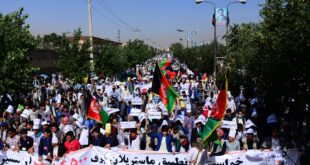Dr, Mohammad Hussain Kholousi
The collapse of the Islamic Republic of Afghanistan and the return of the Taliban group on August 15, 2021, has placed women at the center of systematic discrimination. The dimensions of this discrimination are extensive, and its consequences are catastrophic. This article aims to describe the current situation, introduce the foundations of these restrictions, and explain their consequences. The dire consequences of widespread discrimination against women necessitate reflection on overcoming this situation or, at the very least, mitigating the destructive effects of this phenomenon. Solutions in this regard should be presented
1- The pillars of discrimination
The ideological hostility of the Taliban and the prevailing social norms in Afghanistan have placed women in a highly challenging position. Over fifty decrees have been issued by the Taliban government against women during this period of approximately one and a half years. These decrees have imposed extensive restrictions on Afghan women. Based on these orders, women’s participation in all political, social, economic, and cultural spheres has been limited. The widespread and systematic discrimination against women encompasses these pillars
1-1 The pillars of politics and management
The first interim Taliban cabinet was announced in September 2021, in which no women were included. This trend was further reinforced by the removal of the Ministry of Women’s Affairs. The following month, women were advised to avoid working in government ministries. Subsequently, through a gradual process, ministers issued orders to prohibit women from entering these workplaces. In the realm of politics and management, the most severe restrictions have been imposed on women. Banning women from political participation reflects the Taliban’s perception of the Islamic nature of the government. Currently, women have no presence in any executive positions or roles. The exclusion of women from political and managerial spheres represents the most extreme form of discrimination imposed on a significant portion of Afghanistan’s population.”
1-2 he economic and occupational pillars
Following the exclusion of women from the political and managerial spheres, based on previous orders, the occupational and economic domains of women have also been restricted. Female employees have been dismissed from administrative responsibilities, and this prohibition has been enforced in the private sector as well. Based on Taliban ideological teachings, women’s employment in mixed-gender environments is prohibited, and such environments are perceived as corrupting. However, the Taliban’s extremism goes beyond this, as they have targeted all economic activities of women, including sports. Female officers in the military, female judges, and all female employees of institutions have been removed from their duties. On December 24, 2022, women’s work in non-governmental organizations and national and international organizations was also declared prohibited.
1-3 The cultural and educational pillars
One of the earliest prohibitions imposed on women was the prevention of girls’ attendance in high schools. Following that, on March 21, 2022, a decree was issued banning women from universities. Private tutoring was also instructed not to enroll female students. On September 8, 2021, the Deputy Minister of Information and Culture of the Taliban deemed sports unnecessary and un-Islamic for women. In November 2021, women’s participation in television shows was banned, and female television presenters were ordered to cover their faces during program broadcasts
1-4 The social and civil society pillars
The presence of women in society has been minimized by the Taliban. Their regressive mindset does not tolerate the presence of women in society or even in everyday life. On December 26, 2021, drivers were instructed not to transport women without a male guardian (mahram). Subsequently, restrictions were imposed on women’s travel. On February 27, 2022, women were banned from leaving the country without a male guardian. Women’s driving was also prohibited in the same month, and in November 2022, women were prohibited from entering amusement parks and using public restrooms. In May 2022, the law regarding women’s attire was announced, and it was ordered that in case of non-compliance, the male guardians would also be subject to punishment. Following that, images of women were removed from city billboards, and shopkeepers were ordered to dress mannequins with hijabs
2. The effects and consequences of discrimination against women
Widespread discrimination against women has far-reaching and comprehensive consequences that can be briefly explained as follows:
2-1 Deprivation of political rights:
Deprivation of political rights leads to the exclusion of women from the public sphere and confines them to the private sphere (the domestic environment). This process, over the long term, results in women being reduced to objects and confined to the role of mere tools. Such relegation of women diminishes their inherent dignity as human beings. Furthermore, this deprivation causes psychological humiliation for women, ultimately depriving them of security and peace of mind. The exclusion of women from the public and managerial sphere is detrimental not only to women themselves but also to society. Society misses out on the creativity, ideas, and constructive opinions of women, and women themselves suffer because they experience degradation and objectification.
2-2 Deprivation of civil and cultural rights:
Minimizing the presence of women in society implies a return to patriarchal traditions. Excluding women from education leads to their disempowerment and consequently increases their vulnerability. A significant part of women’s capability, resilience, and their fight for their rights is closely tied to cultural and educational arenas. Depriving them of education during this period will render a generation of vulnerable and entirely dependent women who accept discrimination and the naturalization of their exclusion from public spheres.
2-3 The increase in poverty and social harms
Over the past twenty years, women have made significant progress and have been equipped with various capabilities. The positive discrimination practiced towards them has provided a favorable platform for their cultural growth and economic independence. However, with the deprivation of women from employment, all these achievements are destroyed. Economic deprivation deprives women of their economic independence and transforms them from active, creative, and independent individuals into dependent, vulnerable, and passive individuals. This deprivation poses extraordinary challenges for women and their families, particularly those in poor and single-parent households. It not only widens the scope of poverty and deprivation quantitatively but also intensifies poverty within families, leading to more severe levels of hunger and homelessness. Furthermore, the expansion of poverty is accompanied by an increase in social harms. In the absence of legitimate income for women and their families, resorting to social crimes becomes inevitable.
3. Concrete solutions to reduce the effects of discrimination:
It can be said that achieving gender equality in the current situation may seem far from expectations. However, the following solutions can be somewhat instrumental in reducing discrimination and consequently mitigating the effects of gender inequality. These solutions are listed in order of importance:
3-1 Special and continuous support for vulnerable women:
Ensuring women’s livelihood is their immediate and overriding need. The widespread levels of poverty and hunger not only weaken women’s resilience but also alter their life priorities. International organizations need to pay special attention to the distressing livelihood situation of women in Afghanistan. Although some assistance has been provided thus far, it has not been proportionate to the extent of women’s deprivation. It is expected that livelihood support should correspond to the level and scope of women’s needs. Relief agencies should be mindful that Afghan women are grappling with the most severe life challenges, and in such circumstances, ensuring livelihood should not pose an additional burden on top of existing difficulties.
3-2 Actions of pressure by international forums in order to recognize women’s rights officially.
While the Taliban regime lacks political rationality, there is at least a strategic level of rationality present in them. Continuous pressure from international forums regarding women’s political rights may not have immediate impact, but it will certainly be effective in their civil and social rights. Therefore, international forums should consistently exert pressure on this group to prevent the Taliban’s backward progression and mobilize global public opinion towards holding the Taliban accountable for women’s rights.
3-3 Delegitimization of women’s extremism by religious forums
The harsh interpretation of religion by the Taliban can only be challenged by religious forums. Delegitimizing the discourse of misogyny is an urgent need for women under Taliban rule in Afghanistan. Therefore, maintaining continuous communication between women’s groups and religious forums is crucial. The current situation does not favor women in the clash between Islamic discourse and liberal discourse. The cultural foundations of Afghanistan, in a state of conflict, support the Taliban. Accordingly, it is necessary to initiate religious discourses against the Taliban’s stance on women’s rights and challenge the entire legitimacy of their reactionary interpretation of Islam. Such a process can lead to some flexibilities in the field of women’s rights.
3-4 Encouraging Afghan civil society and intellectuals to support women.
The most significant factor contributing to discrimination in Afghanistan stems from the deeply ingrained gender biases within Afghan society. The civil society, intellectual communities, and overall public opinion in Afghanistan should have responded more appropriately to the extensive discrimination against women. Such complacency provides a fertile ground for the perpetuation of discrimination. To eliminate any form of discrimination, it is essential to first dismantle these gender-based foundations. The intellectual and civil society of Afghanistan must become even more active in supporting women. It is through this cultural groundwork that the normalization of women’s marginalization in society can be prevented.
3-5 Empowerment of girls through virtual education.
The expansion of virtual workshops and e-learning is crucial in empowering women. Women themselves possess great capacities in this field, and it doesn’t require significant expenses. Utilizing this potential necessitates organizational and structural arrangements. The current weakness lies in the absence of such organized institutions and frameworks. There are numerous activities, but they are scattered and lack standardization. If these activities are organized, needs-based, and grounded in reality, e-learning can solidify its importance and position among Afghan women. It is expected that active groups and movements regarding women will provide the necessary structural and institutional capacities to bring schools and universities to homes. Additionally, their continuous communication with the outside world and reflecting their issues in the mass media should be sustained.
3-6 Establishment of a virtual university and provision of scholarships.
After the ban on higher education at universities, a significant portion of female students have been faced with despair and hopelessness. This absolute despair internally undermines women, pushing them towards collapse. Therefore, the continuation of university education and attaining academic degrees is crucial. The continuation of women’s education is a pathway that preserves at least a minimum level of self-confidence among educated women. It should be noted that in this challenging situation, these minimum requirements can be highly valuable social assets for women. This social capital needs to be protected in order to facilitate its return to the cultural arena as a soft infrastructure, benefiting women.
Afghan women intellectuals represent the future of Afghanistan’s national talents and human resources. These resources need to be identified and supported. Nurturing these talents requires global scientific communities to pay special attention to the situation of women and allocate dedicated quotas for scholarships for Afghan girls. Considering the magnitude of the challenges and existing relationships between active women’s groups and international organizations, making the most of this capacity is not beyond reach.
Result:
The control of the Taliban over Afghanistan has put women in a difficult situation. The majority of women’s rights have been ignored, and women in Afghanistan today experience various forms of legal deprivation. To overcome this situation, extensive collaboration among religious institutions, civil society, and international organizations is necessary. This collaboration, in the form of an organized framework, accompanied by a diversity of activities, can partially reduce discrimination and its consequences. However, achieving social justice and gender equality seems highly unlikely.
 حزب شهروندان افغانستان وبسایت رسمی حزب شهروندان افغانستان
حزب شهروندان افغانستان وبسایت رسمی حزب شهروندان افغانستان



